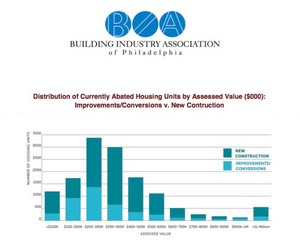PHILADELPHIA, PA--(Marketwired - Mar 24, 2017) - The Building Industry Association of Philadelphia (BIA) commissioned a report to determine the size, location, and distribution of Philadelphia's 10-year tax abatement program. Based on the data presented in the study, it is the BIA's view that the city's tax abatement program is significantly increasing Philadelphia tax revenues and driving residential real estate through improvement, investment and development at all price levels, in all neighborhoods. The first of three studies funded with support from the National Association of Home Builders (NAHB), Pennsylvania Builders Association (PBA), and General Building Contractors Association (GBCA), reveals, contrary to popular belief, typical abated properties are single-family homes priced between $200,000 and $300,000, not million dollar condominiums.
The study provides a sharp contrast in residential construction trends between Philadelphia and the surrounding suburbs. Since the abatement implementation in 2000, real estate development in Philadelphia has more than tripled, increasing by an impressive 376%, while construction slipped 11.25% in the suburbs. Homeowners with expired abatements are contributing an additional $48.1 million in tax revenue annually, effectively growing Philadelphia's real estate tax base by 11%.
"We've seen tremendous growth over the last decade and a half in the residential market since the city implemented the 10-year tax abatement. The program has not only stimulated development, but it also served as a catalyst for the resurgence of Center City as restaurants, shops and businesses began taking root in Philadelphia to serve new homeowners," says James Maransky, Vice President of BIA. "The abatement has also generated renewed interest in neighborhoods outside of Center City as residents seek quality homes and discover the advantages and cost-savings associated with the tax abatement program."
"Throughout the country, we have seen how homeowners benefit from tax abatements. Philadelphia is a perfect example of how getting tax policy right can help drive investment and homeownership in communities," said NAHB Chairman Granger MacDonald, a home builder and developer from Kerrville, Texas.
Economist Kevin C. Gillen, Ph.D., member of the BIA Board of Directors, conducted the study, based on recent data from the Office of Property Assessment (OPA). The report provides an overview of the size, location and distribution of tax-abated properties in Philadelphia. It puts the history and growth of the 10-year tax abatement into context and explains in simple terms how the program benefits homeowners by deferring assessment of improvements to an existing property or the value of a newly constructed building on a parcel of land for real estate taxes.
The largest concentration of abated properties occurs in Center City where density is highest primarily due to the predominance of high-rise condominiums, apartments, and hotels. However, single-family abated properties are dispersed throughout the city with significant development in South Philadelphia, West Philadelphia, Manayunk, Northern Liberties, Fishtown and Kensington. The data shows that 67% of abated properties have an assessed value of less than $400,000 and that 25% of abated residences can be classified as "workforce housing" when put in the context of assessed values and neighborhood incomes. Although critics are quick to point out that the median value of a house in Philadelphia is $145,000, the study concludes that although it may appear that the value of tax abated properties is much higher, it is actually an unfair comparison since the typical home is an unimproved row home built decades ago, while the typical abated home is either a newly constructed or renovated home.
"The BIA study demonstrates the phenomenal increase in residential construction spurred by the 10-year tax abatement and reflects the growth many of our members anecdotally attribute to millennials and young families driving the demand for new housing," says Andrew Kaye, President of PBA.
"There is no doubt in my mind that the huge boom in residential construction is a result of Philadelphia's 10-year tax abatement and this study by the BIA quantifies what all of our members have been experiencing over the past sixteen years," says Jim J. Dolente, Chairman, GBCA Board of Directors.
About Building Industry Association:
For 80 years, the Building Industry Association of Philadelphia (BIA) has represented the homebuilding industry in Philadelphia. Today, as the fastest-growing building association in Pennsylvania, its influence has grown to include mixed-use and nonresidential construction. BIA works to promote a healthy development climate on behalf of a wide range of industry professionals: builders, real estate developers, subcontractors, designers, finance experts, brokers, product manufacturers and others. For more information and a full copy of the 10-Year Property Tax Abatement study, visit www.biaofphiladelphia.com
Contact Information:
Contacts:
Food Shelter PR
Lorraine Gimblett
(917) 523-2327
Joanne Jordan
(917) 673-9305
